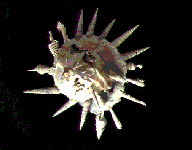|
N A T U R A L
H I S T O R Y
M U S E U M S A N D
R E S E A R C H
C E N T E R S
|
|
Email: Museums@NatureQuest.org
|
|
|
|
|
|
|

( N O N - I N S E C T ) I N V E
R T E B R A T E S
|
.
|
Strength In This Field
Collection:

|
More Info:

|
Where:

|
|
|
|
|
|
|
|
.
|

Museums
of Natural
History
Copenhagen
(Faculty of Science, University of Copenhagen)
Denmark
|
The Department
of Invertebrates
(excluding insects, myriapods and arachnids) has focused its
research primarily on the study of marine invertebrates.
(This is mainly due to the history of the Danish Kingdom,
its navy, its overseas trading activity and its past
interest in colonies.) The most important parts of the
collections are the type collections, and its cataloguing is
still going on. The collection holds many types from the
late 18th century and early 19th century as
follows:
-the
Protozoa section
is a rather complete
collection of Xenophyophora and other types such as the
Foraminifer collection.
-the Porifera collection centers on the North Atlantic,
deep-sea worldwide, and Antarctica.
-the Cnidaria section
includes the
Hydromedusae collection whose coverage is worldwide. The
Hydropolyp collection is very representative for the
North Atlantic, and this is the case also for both main
groups of Anthozoa.
-the Platyhelminthes,
Aschelminthes, and Proarthropods
section is reflective
of the Zoological Museum long history in the study of
"Lower Worms" (Platyhelminthes, Nemertina and
Aschelminthes) and the so-called Proarthropods
(Tardigrada, Onychophora and Pentastomida).
- the "Vermes" (phyla
consisting primarily of macrofauna) section
houses the
collections of five phyla: Annelida (including
Pogonophora and thus also Vestimentifera), Echiura,
Sipuncula, Priapula, and Chaetognatha. Among them,
emphasis in collection and research has historically been
placed on the polychaetous annelids.
-the Collection of
Mollusks is one of
the more important of the large, old collections in
Europe, going back to King Frederik III's "Kunstkammer"
from the 1650's.
-the Crustacea
Collection holds one
of the largest and historically most important
collections of Crustacea held anywhere in the world. The
collection dates back to the immediate post Linnaean
period.
-the Entoprocta
section contains
material from Scandinavia and Florida (USA), including a
number of types of the family Loxosomatidae.
-the Ectoprocta =
Bryozoa Collection
contains large material from all over the world; about
two thirds are in alcohol, the rest is dry.
- the rather small collections from
Phoronida,
Pterobranchia,
Enteropneusta,
Larvacea
sections.
-the Urochordata
section containing a
large collection with material from many expeditions,
including many types.
-the Thaliacea and
Ascidiacea sections
containing large collections from a number of
expeditions.
-the large Echinoderm
Collection is one of
the three largest collections in the world. It contains
some 3731 identified species of the known recent ca. 6300
species in the world, including 613 holotypes and a large
number of paratypes. The collection consists of dry and
wet specimens, a large number of slides (holothurian
ossicles, echinoid and asteroid pedicellariae, larvae and
histological sections of a number of echinoderms). The
Echinoderm Collection is one of the most valuable
documentary collections in the world.
.
|

|
.
|
|
.
|

Albany
Museum
Grahamstown
South Africa
.
|
The collection of
Freshwater
Invertebrates
(insects, crustacea, snails, worms) holds in excess of 1.5
million specimens including over 1000 primary and secondary
types. It comprises ethanol preserved specimens in small
glass-vials, stored in more than 4500 sealed glass jars;
pinned specimens of selected adult insects in unit trays
stored in 160 drawers; microscope slide mounted specimens
and a photographic record of selected specimens and sites
sampled. The collection provides historical records of
species with some material dating back to the 1930's.
Information on more than 120 000 accessions is recorded in
hand written catalogues and on a computer database for ease
of access. Several card index systems allow access to
publications and specimens, and rapid identification of
species from diagnostic drawings.
.
|

|
.
|
|
.
|

Natural
History Museum
Berne
Switzerland
|
 The Invertebrate
Collections date
from the middle of the 19th century to the present. The are
some 200 corrals over 100 years old. In addition, check out
their Malacology, Entomology,
and Herpetology
sections.
The Invertebrate
Collections date
from the middle of the 19th century to the present. The are
some 200 corrals over 100 years old. In addition, check out
their Malacology, Entomology,
and Herpetology
sections.
|

|
.
|
|
.
|

The
Academy of Natural Sciences
Philadelphia, PA,
USA
|
The Invertebrates
Department's
collection is concentrated on localities in the Eastern and
Gulf Coasts of the United States. The collection contains
dry and alcohol-preserved specimens representing 14 phyla
which includes Protozoa, Porifera, Cnidaria,Platyhelminthes,
Gastrotricha, Rotifera, Nemata, Nematomorpha, Annelida,
Arthropoda, Bryozoa, Brachiopoda, and
Echinodermata.
The systematically arranged
collection contains 18,000 lots, about evenly divided
between dry, alcohol-preserved, and prepared slides of
specimens. The collection is strong in the arthropod class
Crustacea, particularly the Decapoda, and in the phylum
Annelida, particularly the classes Polychaeta and
Hirudinoidea. Important taxonomically restricted collections
within the overall collections are:
- Edward Potts Collection:
Porifera (Spongillidae)
- L. M. Dorcy Collection and
Rotifera J. Percy Moore Collection: Annelida
(Polycheata, Hirudinoidae)
- Joseph Leidy Collection:
Parasitic Organisms (Nemata, Nematomorpha),
and
- Felix-Edouard
Guerin-Meneville Collection: Crustacea
.
|

|
.
|
|
|
|
|
|
|
|
|
|
|
|
|
